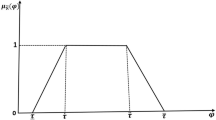Abstract
The purpose of this paper is to investigate the equalities of different types of proper cores and dominance cores for the general worth function \(v\) without assuming it to be nonnegative. The different sufficient conditions are provided in this paper to guarantee the equalities of different proper cores and dominance cores for this general situation.
Similar content being viewed by others
References
Aubin, J.-P. (1981). Locally lipschitz cooperative games. Journal of Mathematical Economics, 8, 241–262.
Aubin, J.-P. (1981). Cooperative fuzzy games. Mathematics of Operations Research, 6, 1–13.
Azrieli, Y., & Lehrer, E. (2007). On some families of cooperative fuzzy games. International Journal of Game Theory, 36, 1–15.
Bector, C. R., Chandra, S., & Vijay, V. (2004). Matrix games with fuzzy goals and fuzzy linear programming duality. Fuzzy Optimization and Decision Making, 3, 255–269.
Borkotokey, S. (2008). Cooperative games with fuzzy coalitions and fuzzy characteristic functions. Fuzzy Sets and Systems, 159, 138–151.
Butnariu, D. (1978). Fuzzy game: A description of concept. Fuzzy Sets and Systems, 1, 181–192.
Butnariu, D., & Kroupa, T. (2008). Shapley mappings and the cumulative value for \(n\)-person games with fuzzy coalitions. European Journal of Operational Research, 186, 288–299.
Chang, S.-S., & Tan, K.-K. (2002). Equilibria and maximal elements of abstract fuzzy economies and qualitative fuzzy games. Fuzzy Sets and Systems, 125, 389–399.
Espin, R., Fernendez, E., Mazcorro, G., & Lecich, M. I. (2007). A fuzzy approach to cooperative n-person games. European Journal of Operational Research, 176, 1735–1751.
Garagic, D., & Cruz, J. B. (2003). An approach to fuzzy noncooperative nash games. Journal of Optimization Theory and Applications, 118, 475–491.
Guiasu, S. (2000). Coping with uncertainty in \(n\)-person games. International Journal of Uncertaint, Fuzziness and Knowledge-Based Systems, 8, 503–523.
Hwang, Y.-A., & Liao, Y.-H. (2008). Max-consistency complement-consistency and the core of fuzzy games. Fuzzy Sets and Systems, 159, 152–163.
Li, S., & Zhang, Q. (2008). The measure of interaction among players in games with fuzzy coalitions. Fuzzy Sets and Systems, 159, 119–137.
Li, S., & Zhang, Q. (2009). A simplified expression of the shapley function for fuzzy game. European Journal of Operational Research, 196, 234–245.
Maeda, T. (2003). On characterization of equilibrium strategy of two-person zero-sum games with fuzzy payoffs. Fuzzy Sets and Systems, 139, 283–296.
Mareš, M. (2000). Fuzzy coalition structures. Fuzzy Sets and Systems, 114, 23–33.
Mareš, M., & Vlach, M. (2001). Linear coalitional games and their fuzzy extensions. International Journal of Uncertaint, Fuzziness and Knowledge-Based Systems, 9, 341–354.
Molina, E., & Tejada, J. (2002). The equalizer and the lexicographical solutions for cooperative fuzzy games: Characterization and properties. Fuzzy Sets and Systems, 125, 369–387.
Tijs, S. H., Branzei, M. R., Ishihara, S., & Muto, S. (2004). On cores and stable sets for fuzzy games. Fuzzy Sets and Systems, 146, 285–296.
Vidyottama, V., Chandra, S., & Bector, C. R. (2004). Bi-matrix games with fuzzy goals and fuzzy pay-offs. Fuzzy Optimization and Decision Making, 3, 327–344.
Vijay, V., Chandra, S., & Bector, C. R. (2005). Matrix games with fuzzy goals and fuzzy payoffs. Omega, 33, 425–429.
Vijay, V., Mehra, A. V., Chandra, S., & Bector, C. R. (2007). Fuzzy matrix games via a fuzzy relation approach. Fuzzy Optimization and Decision Making, 6, 299–314.
Wu, H.-C. (2012). Proper cores and dominance cores of fuzzy games. Fuzzy Optimization and Decision Making, 11, 47–72.
Wu, H.-C. (2012). Cores of fuzzy games and their convexity. Fuzzy Sets and Systems, 198, 59–69.
Author information
Authors and Affiliations
Corresponding author
Rights and permissions
About this article
Cite this article
Wu, HC. Unifying the proper cores and dominance cores of cooperative fuzzy games. Fuzzy Optim Decis Making 14, 243–263 (2015). https://doi.org/10.1007/s10700-014-9203-3
Published:
Issue Date:
DOI: https://doi.org/10.1007/s10700-014-9203-3




